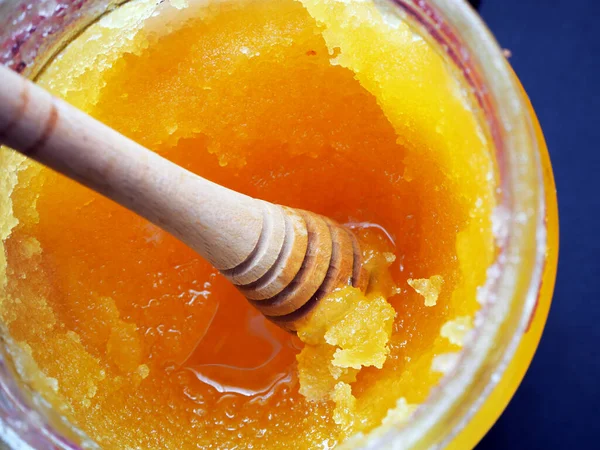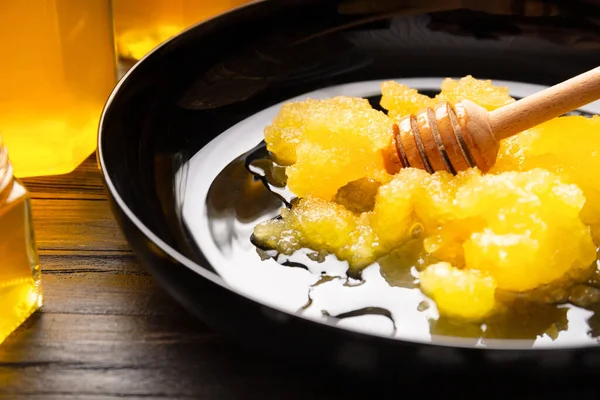Honey is a natural sweetener that has been used for centuries for its health benefits. However, what happens when honey crystallizes? Is it still safe to eat?
Wondering what it means to have honey crystallizes? Let’s explain!
Crystallized honey, also known as granulated or candied honey, is a natural process where honey transforms from its liquid form into a semi-solid, grainy texture. This happens due to the natural composition of honey, primarily consisting of sugars, water, and other components like pollen, enzymes, and minerals. The sugars, namely glucose and fructose, come together and form crystals, leading to the thickening of honey.
The Science Behind Crystallization

Crystallization is a common phenomenon in honey due to its high sugar content. The process is influenced by factors such as temperature, glucose-to-water ratio, and the presence of pollen grains, which act as nucleation points for the formation of crystals. Honey with a higher glucose-to-water ratio tends to crystallize faster. Now, is crystallized honey bad for your health?
Is Crystallized Honey Bad For Your Health?

No, crystallized honey is not bad for your health. In fact, it is still just as nutritious as liquid honey. The crystallization process does not change the honey’s chemical composition or nutritional value. The only difference is that the texture of crystallized honey is more solid and grainy.
However, more study needs to be done on the subject. Contrary to some findings, one study reported that crystallization has a negative influence on honey because it promotes the growth of fungi and yeast.
There are a few reasons why honey crystallizes. One reason is that honey contains more sugars than water. When the honey is stored in a cool, dark place, the sugars slowly start to come out of solution and form crystals.
Another reason for crystallization is that honey contains small amounts of enzymes that can break down the sugars into smaller molecules. These smaller molecules are more likely to crystallize.
Crystallized honey is still safe to eat. You can eat it as is, or you can decrystallize it by heating it gently in a warm water bath. If you decrystallize the honey, it will return to its liquid state.
There are actually some benefits to eating crystallized honey. Which includes;
- It is a good substitute for sugar in baking. The lower moisture content of crystallized honey means that you do not need to make any adjustments to the liquids in your recipe.
- It has a longer shelf life than liquid honey. Crystallized honey can last for up to 2 years, while liquid honey only lasts for about 1 year.
- It can be used as an exfoliant for the skin. The grainy texture of crystallized honey can help to remove dead skin cells and leave your skin feeling smooth and soft.
- It can be used as a cough suppressant. The honey’s natural sweetness can help to soothe a sore throat, and its antibacterial properties can help to fight off infection.
- It can help to improve digestion. The honey’s enzymes can help to break down food and promote the growth of healthy bacteria in the gut.
- Wound healing properties. Applied topically, crystallized honey exhibits antibacterial properties that can aid in wound healing and provide relief from burns and cuts.
- Antioxidant power. Crystallized honey is rich in antioxidants that combat free radicals, reducing oxidative stress and promoting overall well-being.
- Immune system support. The natural antibacterial and antifungal properties of crystallized honey can bolster the immune system, helping the body fight off infections.
Here are some studies that support the claim that crystallized honey is not bad for your health:
- A study published in the journal “Food Science and Technology” found that crystallized honey had the same nutritional value as liquid honey.
- A study published in the journal “Journal of Agriculture and Food Chemistry” found that crystallized honey had a higher antioxidant activity than liquid honey.
RELATED: Is Honey Good for Blood Type O Positive?
Best Uses of Crystallized Honey

READ RELATED: Pawpaw Fruit: 8 Reasons to Add This Antioxidant Powerhouse to Your Diet
Here are some of the best uses of crystallized honey:
- As a sweetener: Crystallized honey can be used as a sweetener in a variety of dishes, including tea, coffee, smoothies, yogurt, and oatmeal. It can also be used to make baked goods, such as cookies, cakes, and muffins.
- As an exfoliant: The grainy texture of crystallized honey makes it a natural exfoliant for the skin. To use it as an exfoliant, simply rub a small amount of honey on your damp skin in a circular motion. Rinse with warm water and pat dry.
- As a cough suppressant: The honey’s natural sweetness can help to soothe a sore throat, and its antibacterial properties can help to fight off infection. To use crystallized honey as a cough suppressant, simply take a teaspoon of honey before bed.
- As a glaze: Crystallized honey can be used as a glaze for meats, fish, and vegetables. To make a glaze, simply mix together equal parts crystallized honey and water. Brush the glaze over the food before cooking or baking.
- As a spread: Crystallized honey can be spread on bread, toast, or crackers. It can also be used as a filling for pastries and sandwiches.
How to Stop Honey from Crystallizing

There are a few things you can do to slow down the process and keep your honey liquid for longer.
Here are some tips on how to stop honey from crystallizing:
- Store the honey in a cool, dark place. The ideal temperature for storing honey is between 50 and 70 degrees Fahrenheit. Storing honey in a warm environment will accelerate the crystallization process.
- Keep the honey in an airtight container. This will help to prevent moisture from getting into the honey, which can also cause it to crystallize.
- Avoid storing honey in the refrigerator. The cold temperature of the refrigerator can cause the honey to crystallize more quickly.
- Add a small amount of corn syrup to the honey. Corn syrup is a type of sugar that can help to prevent crystallization. Add 1 teaspoon of corn syrup to every cup of honey.
- Microwave the honey on low power for 30 seconds at a time, stirring in between. This will help to break up the crystals and keep the honey liquid for longer.
How to Decrystallize Honey

Here are some ways to decrystallize honey:
Warm water bath:
- Place the jar of honey in a heatproof bowl.
- Fill the bowl with warm water until it reaches halfway up the jar.
- Let the honey sit in the warm water for 30 minutes to 1 hour, or until it has liquefied.
- Stir the honey to help it dissolve.
- Remove the jar from the water and let it cool completely.
Microwave:
- Place the honey in a microwave-safe container.
- Microwave the honey on low power for 30 seconds at a time, stirring in between, until it has liquefied.
- Be careful not to overheat the honey, as this could damage the enzymes.
- Let the honey cool completely.
Stovetop:
- Place the jar of honey in a saucepan.
- Fill the saucepan with enough water to come halfway up the jar.
- Heat the water over low heat until it is just simmering.
- Let the honey sit in the simmering water for 30 minutes to 1 hour, or until it has liquefied.
- Stir the honey to help it dissolve.
- Remove the jar from the water and let it cool completely.
Important notes:
- Do not heat the honey above 110°F, as this could damage the enzymes.
- If you are decrystallizing a large quantity of honey, you may need to increase the cooking time.
- Once the honey has liquefied, it is important to let it cool completely before storing it. This will help to prevent it from crystallizing again.
Buying and Storing Crystallized Honey – Tips

Buying crystallized honey:
- Look for honey that is labeled as “raw” or “unprocessed.” This type of honey will have a higher concentration of enzymes and nutrients, which can help to prevent crystallization.
- Choose honey that is stored in a glass jar. Glass is a non-reactive material that will not interact with the honey and cause it to crystallize.
- Avoid honey that is stored in plastic containers. Plastic can leach chemicals into the honey, which can accelerate crystallization.
Storing crystallized honey:
- Store the honey in a cool, dark place. The ideal temperature for storing honey is between 50 and 70 degrees Fahrenheit.
- Keep the honey in an airtight container. This will help to prevent moisture from getting into the honey, which can also cause it to crystallize.
- If you live in a cold climate, you may want to store the honey in the refrigerator. This will help to slow down the crystallization process.
Myths about Crystallized Honey Debunked
Crystallized Honey is Spoiled – Fact: Crystallization is a natural process and does not indicate spoilage. The honey is still safe to eat.
Crystallized Honey Loses Nutrients – Fact: Crystallized honey retains its nutritional value, including vitamins, minerals, and antioxidants.
Reversing Crystallization is Harmful – Fact: It is safe to restore crystallized honey to its liquid state by gently warming it. Avoid microwaving as it may reduce its nutritional benefits.




